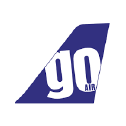GO Airlines India Ltd. IPO Details
| Bidding Dates | Min. Investment | Lot Size | Price Range | Issue Size | IPO Doc |
| Invalid date – Invalid date | ₹0 | null | ₹0 – ₹0 | 3600.00 Cr | RHP PDF |
Description
GO Airlines India Ltd. IPO Details GoFirst, earlier known as Go Air, is an ultra-low-cost carrier (ULCC). As of February 10, 2021, Go First had an inventory of 56 aircraft, of which 46 aircraft were A320 NEO, and 10 were A320 CEO models. As of January 31, 2020, Go First covered a network of 28 domestic and 9 international destinations. The airline has a position in crucial airports such as New Delhi, Mumbai, Ahmedabad, Pune, etc. The company rebranded itself to ‘Go First’ from ‘Go Air’ in May 2021.
Qualities
- Seating capacity of 186 passengers for Airbus NEO aircraft and 180 passengers for Airbus CEO aircraft.
- Average age of their aircraft was around 3.7 years as of February 2021, making it one of the youngest fleet in India and globally.
- Passenger volume increased at a CAGR of 22.4%, from 10.8 million passengers in FY18 to 16.2 million in FY20.
- The company’s market share increased from 8.8% in the financial year 2017-18 to 10.8% in FY2019-20.
- Third highest aircraft utilization of 12.9 hours per day in India in FY19-20.
- Order book of 98 A320 NEO aircraft to be received over a couple of years.
- Marketing efforts focused on the under-45 age group- the largest component of the Indian population.
- Passenger revenue has grown at a CAGR of 24.8 % from fiscal 2018 to fiscal 2020
- Total passenger volume for FY18, 2019 and 2020 and April to December 31, 2020, was 10.8 million, 12.7 million, 16.2 million and 2.4 million, respectively.
- Slot shares in India for FY2020 at key leisure markets: Leh-47%, Srinagar-23% and Port Blair-21% and 65% among Indian airlines flying to Phuket.
Risks
- Adverse impact of COVID-19 pandemic business, operating results, financial condition and liquidity
- For December 2020, departures were at 63% of the departures during December 2019.
- Payment default in aircraft lease agreements, aircraft purchase agreement, increasing level of indebtedness due to the pandemic
- Unable to implement ULCC model due to inability to generate high revenues and lower utilisation of aircraft
- Net loss of Rs 470.69 crores between April to December 2020.
- Multiple factors such as inability to grow the network, delay/failure in fulfilling aircraft orders, changes in cost structures, and more can negatively impact growth strategy.
- Airline industry experiences low-profit margins and high fixed costs
- Impact of price and availability of aircraft fuel
- Reputation could be affected due to an emergency, accident or incident involving aircraft, staff or passengers.
- Aviation insurers have increased premiums increasing the inability to maintain adequate insurance cover.
- Entire projected fleet comprises Airbus A320 family aircraft. Any problem with the Airbus A320 aircraft or Pratt & Whitney engines could affect operations.
- Reliance on automated systems and the internet increases exposure to risks from systems failures and security breaches.



